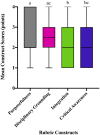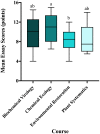Crossing Boundaries: Steps Toward Measuring Undergraduates' Interdisciplinary Science Understanding
- PMID: 32108558
- PMCID: PMC8697648
- DOI: 10.1187/cbe.19-09-0168
Crossing Boundaries: Steps Toward Measuring Undergraduates' Interdisciplinary Science Understanding
Abstract
A desired outcome of education reform efforts is for undergraduates to effectively integrate knowledge across disciplines in order to evaluate and address real-world issues. Yet there are few assessments designed to measure if and how students think interdisciplinarily. Here, a sample of science faculty were surveyed to understand how they currently assess students' interdisciplinary science understanding. Results indicate that individual writing-intensive activities are the most frequently used assessment type (69%). To understand how writing assignments can accurately assess students' ability to think interdisciplinarily, we used a preexisting rubric, designed to measure social science students' interdisciplinary understanding, to assess writing assignments from 71 undergraduate science students. Semistructured interviews were conducted with 25 of those students to explore similarities and differences between assignment scores and verbal understanding of interdisciplinary science. Results suggest that certain constructs of the instrument did not fully capture this competency for our population, but instead, an interdisciplinary framework may be a better model to guide assessment development of interdisciplinary science. These data suggest that a new instrument designed through the lens of this model could more accurately characterize interdisciplinary science understanding for undergraduate students.
Figures




Similar articles
-
From Theory to Practice: Gathering Evidence for the Validity of Data Collected with the Interdisciplinary Science Rubric (IDSR).CBE Life Sci Educ. 2020 Sep;19(3):ar33. doi: 10.1187/cbe.20-02-0035. CBE Life Sci Educ. 2020. PMID: 32720841 Free PMC article.
-
A Framework to Guide Undergraduate Education in Interdisciplinary Science.CBE Life Sci Educ. 2019 Jun;18(2):es3. doi: 10.1187/cbe.18-11-0226. CBE Life Sci Educ. 2019. PMID: 31120394 Free PMC article.
-
Improving undergraduate education in immunology through assessment of interdisciplinary scientific knowledge.Immunol Cell Biol. 2025 Feb;103(2):127-136. doi: 10.1111/imcb.12815. Epub 2024 Aug 20. Immunol Cell Biol. 2025. PMID: 39165096 Free PMC article.
-
Implementing goals for non-cognitive outcomes within a basic science course.Acad Med. 2002 Sep;77(9):931-2. doi: 10.1097/00001888-200209000-00035. Acad Med. 2002. PMID: 12228102 Review.
-
Writing across the curriculum: putting theory into practice in animal science courses.J Anim Sci. 1996 Nov;74(11):2810-27. doi: 10.2527/1996.74112810x. J Anim Sci. 1996. PMID: 8923196 Review.
Cited by
-
Agar Art: a CURE for the Microbiology Laboratory.J Microbiol Biol Educ. 2021 Jul 30;22(2):e00121-21. doi: 10.1128/jmbe.00121-21. eCollection 2021 Fall. J Microbiol Biol Educ. 2021. PMID: 34594457 Free PMC article.
-
Biology Instructors See Value in Discussing Controversial Topics but Fear Personal and Professional Consequences.CBE Life Sci Educ. 2023 Sep;22(3):ar28. doi: 10.1187/cbe.22-06-0108. CBE Life Sci Educ. 2023. PMID: 37279089 Free PMC article.
-
From Theory to Practice: Gathering Evidence for the Validity of Data Collected with the Interdisciplinary Science Rubric (IDSR).CBE Life Sci Educ. 2020 Sep;19(3):ar33. doi: 10.1187/cbe.20-02-0035. CBE Life Sci Educ. 2020. PMID: 32720841 Free PMC article.
-
A resource for understanding and evaluating outcomes of undergraduate field experiences.Ecol Evol. 2021 Nov 19;11(23):16387-16408. doi: 10.1002/ece3.8241. eCollection 2021 Dec. Ecol Evol. 2021. PMID: 34938443 Free PMC article.
References
-
- American Association for the Advancement of Science. (2011). Vision and change: A call to action. Final report. Washington, DC. Retrieved July 22, 2019, from http://visionandchange.org/finalreport
-
- American Educational Research Association, American Psychological Association, & National Council on Measurement in Education. (2013). Standards for educational and psychological testing. Washington, DC: American Educational Research Association.
-
- Balgopal, M. M., Wallace, A. M. (2009). Decisions and dilemmas: Using writing to learn activities to increase ecological literacy. Journal of Environmental Education, 40(3), 13–26.
-
- Balgopal, M. M., Wallace, A. M., Dahlberg, S. (2012). Writing to learn ecology: A study of three populations of college students. Environmental Education Research, 18(1), 67–90.
-
- Balgopal, M. M., Wallace, A. M., Dahlberg, S. (2017). Writing from different cultural contexts: How college students frame an environmental SSI through written arguments. Journal of Research in Science Teaching, 54(2), 195–218.

